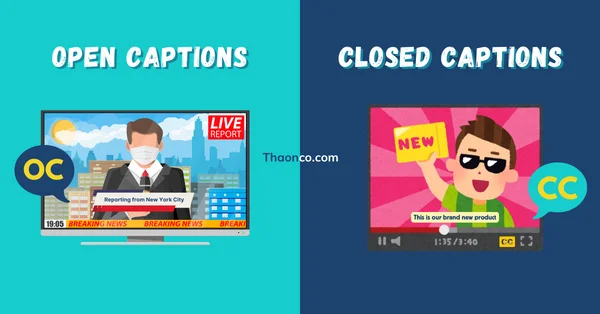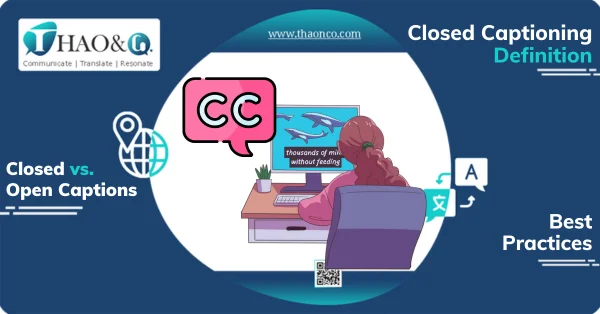What is Closed Captioning? Why are Closed Captions important for media accessibility? Read on with Thao & Co. to discover the significance of closed captions and best practices for effective Closed Captioning.
Before anything else, let’s look into the definition of Closed Captions. Closed Captions are on-screen texts displayed during a video or a TV broadcast as a written representation of its dialogues and non-speech elements.
This type of caption provides viewers with access to the audio of the content including spoken words, background music, and sound effects without hearing it. This is especially helpful for individuals with hearing impairment or situations with loud background noises where the audio can’t be heard.
Closed Captions include not only a transcript of dialogues but also a description of nonverbal elements like character laughing, door closing, or bell ringing, allowing viewers to engage effectively with the content. Closed Captions are typically displayed at the bottom of the screen and can be turned on or off by choice.
Closed Captions are now widely incorporated in TV programs as well as content distributed on live-streaming sites and video platforms like YouTube and Netflix.
Closed Captions not only ensure video content is accessible to all viewers regardless of their hearing ability but also help with foreign language learning and comprehension.
How are Closed Captions different from Open Captions? Both Closed Captions and Open Captions are text versions of the audio of TV programs, movies, and videos.

Though sharing the same function, the two types of captioning differ in their display feature and use. Both Closed and Open Captions display audio information crucial for viewers’ understanding of and engagement with the content such as spoken words, music, and sound effects.
The key difference between the two lies in user control of caption visibility. While Closed Captions allow viewers to decide whether to toggle them on or not, Open Captions are burnt into the video and cannot be disabled.
Open captions are typically used in TV broadcasts and movies to accommodate a mass audience. Closed captions, on the other hand, are employed by platforms like YouTube, Netflix, and TikTok to give users control of their own streaming experience.
Closed Captions and Subtitles are often used interchangeably, yet there are in fact significant distinctions between the two. What sets Closed Captions and Subtitles apart is their purpose and the information they convey.
Subtitles serve the purpose of conveying a video’s dialogue to assist with comprehension, whereas Closed Captions provide a more holistic representation of a video’s soundtrack.
Closed Captions include not only dialogues but nonverbal elements as well, making content accessible for viewers with hearing impairment or situations where the audio can’t be played or heard.
Closed Captions play a critical role in ensuring TV broadcasts and video content are accessible to everyone, including individuals with hearing impairment.

Here are the top 5 pros of Closed Captions:
Certain rules should be followed in order to create effective and good-quality Closed Captions. Here are some best practices for Closed Captioning:
In the landscape of content distribution, making sure content is accessible to a mass audience worldwide has become one of the non-negotiables. This has highlighted the need for multilingual Closed Captioning services – a powerful tool to break language barriers and reach a broader audience.
How to find a reliable and high-quality captioning service? Consider Thao & Co. – a trusted agency that provides multilingual closed captioning services for your video content.
Accuracy, compatibility, and synchronization are our topmost priorities when creating captions and subtitles. With a highly skilled and experienced team of linguists and specialists, Thao & Co. offers a full suite of services that can help bring your content to global audiences.

Thao & Co.’s credibility is built on client satisfaction and product quality. We take pride in having an international clientele consisting of video platforms, broadcasts, and film producers.
At Thao & Co, we provide customized multilingual Subtitling services that come with a wealth of benefits:
Not only a great choice of close captioning service, Thao & Co. can also be your long-term strategic partner as we assist you in overcoming language and cultural barriers to global success.
Interested in opening up your content to a broader audience with Thao & Co.? Contact us today.